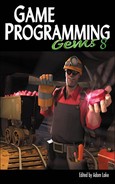- Copyright
- Preface
- Acknowledgments
- Contributors
- 1. Graphics
- Introduction
- 1.1. Fast Font Rendering with Instancing
- 1.2. Principles and Practice of Screen Space Ambient Occlusion
- 1.3. Multi-Resolution Deferred Shading
- 1.4. View Frustum Culling of Catmull-Clark Patches in DirectX 11
- 1.5. Ambient Occlusion Using DirectX Compute Shader
- 1.6. Eye-View Pixel Anti-Aliasing for Irregular Shadow Mapping
- 1.7. Overlapped Execution on Programmable Graphics Hardware
- 1.8. Techniques for Effective Vertex and Fragment Shading on the SPUs
- 2. Physics and Animation
- Introduction
- 2.1. A Versatile and Interactive Anatomical Human Face Model
- 2.2. Curved Paths for Seamless Character Animation
- 2.3. Non-Iterative, Closed-Form, Inverse Kinematic Chain Solver (NCF IK)
- 2.4. Particle Swarm Optimization for Game Programming
- A Few Words on Optimization
- The PSO Paradigm and Its Canonical Formulation
- Add-Ons to the Classical Formulation
- A Note on Randomness
- Case Study 1: Typical Benchmarking Functions
- Case Study 2: Optimization of Physical Parameters for In-Game Vehicle Simulation
- Case Study 3: Physics-Based Animation of Mechanical Systems
- Conclusion
- References
- 2.5. Improved Numerical Integration with Analytical Techniques
- Classifying Errors
- Kinematics of Constant Acceleration
- The Kinematic Integrator
- Integral Contributions Due to a Spring Force
- Multiple Forces
- Integral Contributions of a Pulse
- Integral Contributions of Collision Forces
- Integral Contributions of Viscous Forces
- Integral Contributions of Constraint Forces
- Summary
- Conclusion
- 2.6. What a Drag: Modeling Realistic Three-Dimensional Air and Fluid Resistance
- 2.7. Application of Quasi-Fluid Dynamics for Arbitrary Closed Meshes
- 2.8. Approximate Convex Decomposition for Real-Time Collision Detection
- 3. AI
- Introduction
- 3.1. AI Level of Detail for Really Large Worlds
- 3.2. A Pattern-Based Approach to Modular AI for Games
- 3.3. Automated Navigation Mesh Generation Using Advanced Growth-Based Techniques
- 3.4. A Practical Spatial Architecture for Animal and Agent Navigation
- 3.5. Applying Control Theory to Game AI and Physics
- 3.6. Adaptive Tactic Selection in First-Person Shooter (FPS) Games
- 3.7. Embracing Chaos Theory: Generating Apparent Unpredictability through Deterministic Systems
- 3.8. Needs-Based AI
- 3.9. A Framework for Emotional Digital Actors
- 3.10. Scalable Dialog Authoring
- 3.11. Graph-Based Data Mining for Player Trace Analysis in MMORPGs
- 4. General Programming
- Introduction
- 4.1. Fast-IsA
- 4.2. Registered Variables
- 4.3. Efficient and Scalable Multi-Core Programming
- 4.4. Game Optimization through the Lens of Memory and Data Access
- 4.5. Stack Allocation
- 4.6. Design and Implementation of an In-Game Memory Profiler
- 4.7. A More Informative Error Log Generator
- 4.8. Code Coverage for QA
- 4.9. Domain-Specific Languages in Game Engines
- 4.10. A Flexible User Interface Layout System for Divergent Environments
- 4.11. Road Creation for Projectable Terrain Meshes
- 4.12. Developing for Digital Drawing Tablets
- 4.13. Creating a Multi-Threaded Actor-Based Architecture Using Intel® Threading Building Blocks
- 5. Networking and Multiplayer
- Introduction
- 5.1. Secure Channel Communication
- 5.2. Social Networks in Games: Playing with Your Facebook Friends
- 5.3. Asynchronous I/O for Scalable Game Servers
- 5.4. Introduction to 3D Streaming Technology in Massively Multiplayer Online Games
- 6. Audio
- 7. General Purpose Computing on GPUs
- Introduction
- 7.1. Using Heterogeneous Parallel Architectures with OpenCL
- 7.2. PhysX GPU Rigid Bodies in Batman: Arkham Asylum
- Requirements
- Shape Representation
- Dynamics Algorithm
- Pipeline
- Transform Spheres into World Space
- Sphere-Sphere Collision Detection
- Sphere-Mesh Collision Detection
- Evaluate Force Fields
- Calculate Unconstrained Velocities
- Generate Constraints
- Solver
- Update Positions
- GPU Implementation
- CUDA Voxelizer
- Spatial Data Structures
- Solver
- Conclusion
- Acknowledgements
- References
- 7.3. Fast GPU Fluid Simulation in PhysX
- Color Plate

Color Plate 1: Final results of the SSAO technique presented in Gem 1.2. The top-left pane shows lighting without the ambient occlusion, while the top-right pane shows lighting with the SSAO component mixed in. The final colored result is shown in the bottom image. Here the SSAO samples are very wide, bathing the background area with an effect that would otherwise only be obtained with a thorough global illumination algorithm. The SSAO term adds depth to the scene and helps anchor the characters within the environment.

Color Plate 2: Comparison of large- versus small-area SSAO samples from Gem 1.2. The images show the contrast between the large-area, low-contrast SSAO sampling component on the bar surface and background in the image on the left and the tighter, higher-contrast SSAO samples apparent within the helmet and nooks and crannies found on the character’s space suit in the middle image. Final output is on the right.
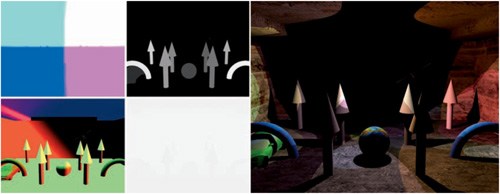
Color Plate 3: Output of rendering stages and final image from the deferred rendering technique described in Gem 1.3. Position and material ID (top left), normal and depth G-buffers (bottom left), and a resultant image (right).
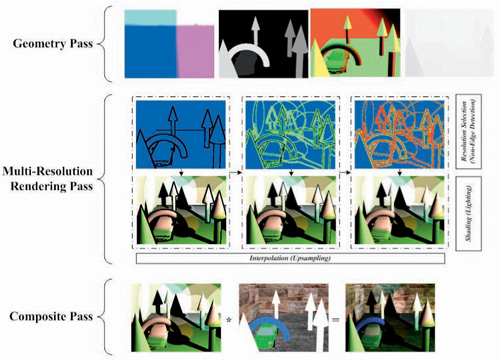
Color Plate 4: The deferred shading technique presented in Gem 1.2 has three steps: geometry pass, multi-resolution rendering pass, and composite pass.

Color Plate 5: A screenshot of Blur. The SPUs are used to compute position and normal offsets to deform the car as it takes damage. More details are in Gem 1.8.
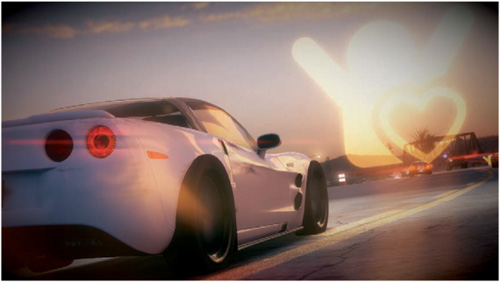
Color Plate 6: A screenshot of Blur, showing a final result of the SPU-based lighting system presented in Gem 1.8.

Color Plate 7: Test face models while performing basic expressions from the anatomical human face model presented in Gem 2.1. From left to right: neutral, joy, sadness, surprise, disgust, and fear.

Color Plate 8: Segmentation results and piecewise convex approximations of different 3D meshes presented in Gem 2.8. (T number of triangles of the original mesh, D length of the diagonal of its bounding box, α = 0.03 × D and the K number of the ACD clusters.)
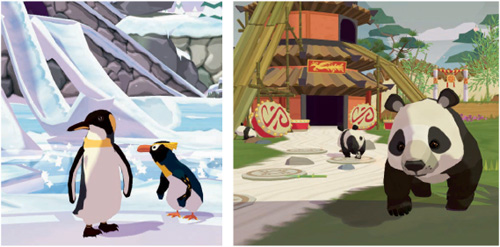
Color Plates 9 and 10: From Gem 3.4, examples of characters in World of Zoo’s (WOZ’s) environment. Characters move through the environment in a spatially appropriate and consistent manner when using the technique presented in this gem.
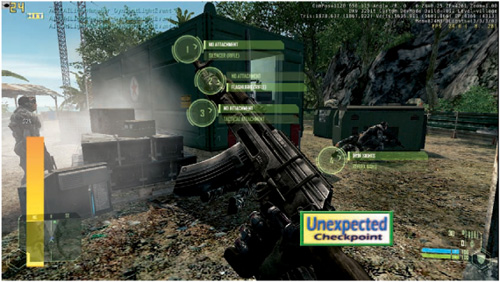
Color Plate 11: Example output from Gem 4.8 demonstrating an approach to testing code coverage. © Courtesy of Crytek GmbH and Electronic Arts, Inc.

Color Plate 12: Destructible wall section being placed into Batman in Unreal Editor from Gem 7.2.

Color Plates 13 and 14: Destruction showing sphere representation of rigid bodies and rendered geometry from Gem 7.2.

Color Plate 15: Batman: Arkham Asylum with interactive PhysX SPH ground smoke, as described in Gem 7.3.
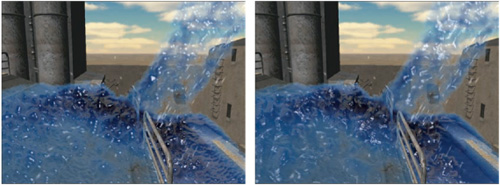
Color Plate 16: A close-up of screen-space fluid rendering with depth smoothing via Gaussian blur (left) and curvature flow (right) from Gem 7.3. The rendering on the right also uses surface Perlin noise to add visual detail.
-
No Comment
